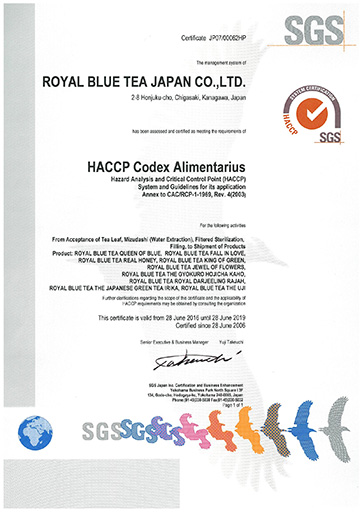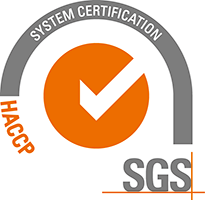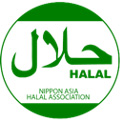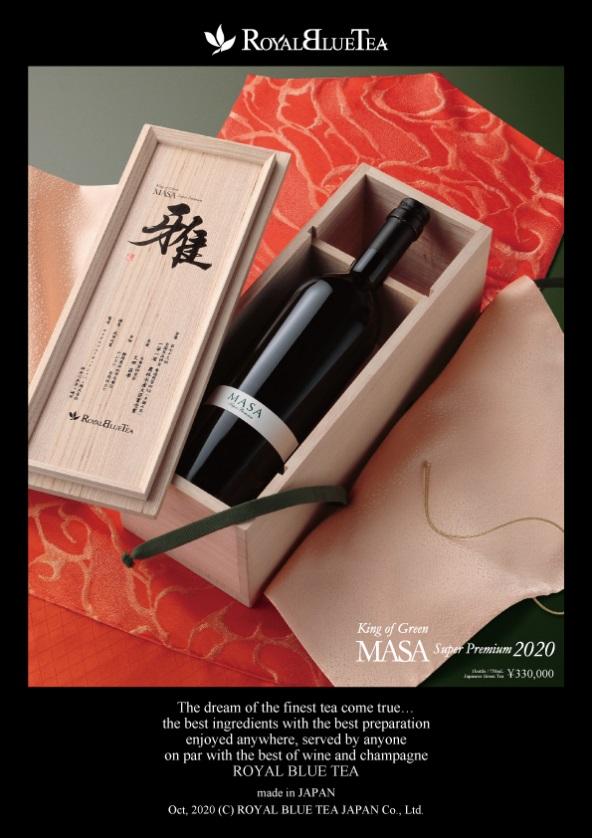The Brand Story of ROYAL BLUE TEA
If this is tea, what was I drinking before?
The finest, hand-picked, naturally grown tea leaves
To be enjoyed anywhere, at any time, by anybody
On a par with the best of wine and champagne
The dream of the perfect tea come true
ワインボトルに入った手摘み高級茶、ロイヤルブルーティーは、本物のお茶を伝えたい一心で作りました。
お茶といえば「機械摘み茶・ブレンド・着香」、しかも「高級茶は淹れ方がむずかしい」という現実。
それならば、高級茶の真髄である、手摘み茶・FTGFOPがあること。
お茶を淹れなくても高級茶を愉しめるようにしたい、という熱い想いで開発が始まり、2007年5月に誕生しました。
本物の高級茶の「色・香・味」を伝えるため原材料は「手摘み茶」のみ。
3~7日間、手間と時間をかけ非加熱抽出・非加熱ろ過除菌充填。薬品や食品添加物は使用せず、加熱殺菌もしていないため、
微生物(一般細菌・大腸菌群・黴・酵母・ウィルス)を制御した、SGS-HACCP認証を取得した厳格な衛生・品質管理基準の下、
クリーンルームの中で、手仕事で製造しています。
お茶は紀元前から上流階級の人しか愉しめなかった高級嗜好品。
ロイヤルブルーティーは、いつでも・どこでも・誰でもワイングラスに注ぐだけで、
ワイン・シャンパンと同じ価値で料理と会話のマリアージュが叶う高級ノンアルコール。
誰でも平等に愉しめる、新たな生活様式、「茶宴」「愉茶」として文化創造します。
ロイヤルブルーティージャパン株式会社
神奈川県茅ケ崎市本宿町2-8 電話0467-50-0806(代)
SGS-HACCP認証工場及びNAHAハラール認証取得
営業許可証:清涼飲料水製造業・食品製造業・食品販売業・器具容器包装おもちゃの製造又は販売業・飲食店営業



「ロイヤルブルーティー」は、2006年5月会社設立のロイヤルブルーティージャパン㈱が、2007年5月より、高級ノンアルコールとしてワインボトル入り高級ボトルドティーを自社開発一貫製造販売するお茶のブランドの総称。
厳格な基準で選別した「手摘み茶」のみが原料。原料に薬剤、添加物を使用しない、微生物制御した衛生・品質管理の下、非加熱抽出・非加熱濾過除菌充填。クリーンルームで、ほとんどの工程を手仕事で製造。商品は1本750ml、3,800~60万円(税抜/2022年9月価格改定時からは、5,000円~60万円税抜)、多品種小ロット20数アイテム、唯一無二の製法で自社製造した商品は全て販売する生産方式(食品ロス0工場経営)。神奈川・茅ヶ崎に自社工場と東京・六本木に直営店を構えています。
商品は、G7伊勢志摩サミット、G20大阪サミットなど国賓をもてなす宴席で公式ノンアルコールとして採用。銀座三越やそごう横浜店、髙島屋など、有名百貨店で取り扱い。著名なホテルや旅館のインルーム、高級レストラン、バーなどでもロイヤルブルーティーを提供。2011年より日本航空国際線ファーストクラス採用。航空会社史上初、機内での高級ノンアルコールのサービスは2022年5月、満11年を迎えます。ロイヤルブルーティーの食の安全の取組は、2007年発売から、世界的トップクラスの国際認証機関SGS-HACCP認証取得。創業から、厳格な衛生・品質管理体制で製造を維持しています。
- HACCP:Hazard Analysis and Critical Control Point.危害分析重要管理点
- ハサップは食の安全性を維持する国際基準。国連の国連食糧農業機関[FAO]と世界保健機関[WHO]の合同機関である食品規格委員会から発表され、各国にその採用を推奨している衛生管理手法。日本は、2021年6月、食品に関わる全事業者対象にHACCP制度義務化。
- FTGFOP:Fine Tippy Golden Flowery Orange Pekoe ファイン・ティッピー・ゴールデン・フラワリー・オレンジ・ペコ
- 紅茶の世界共通のクラシフィケーション表記。手摘みされた上質の新芽がたくさん含み、茶湯の水色が美しい黄金色を呈すもの。goldenは新芽の色と茶湯の水色双方を意味する。
- SGS-HACCP認証
- SGS による HACCP(危害分析重要管理点)認証を受けることで、食品安全管理および製品品質を厳格に維持しています。SGSはスイスを拠点とする、世界的トップクラスの検査、検証、試験および認証機関。
The Brand Story of ROYAL BLUE TEA
If this is tea, what was I drinking before?
The finest, hand-picked, naturally grown tea leaves
To be enjoyed anywhere, at any time, by anybody
On a par with the best of wine and champagne
The dream of the perfect tea come true
Hand-picked premium tea in a wine bottle, Royal Blue Tea was born from the earnest desire to spread authentic tea. Today most tea is mechanically harvested, blended, and contains artificial flavors. Most people’s image of premium tea is that it is difficult to brew by yourself. Determined to create a beverage made with the finest hand-picked FTGFOP tea—the quintessential premium tea—that people can enjoy without having to prepare it themselves, we got to work on development. In May 2007, we succeeded.
Containing only hand-picked tea leaves to ensure it has the color, aroma, and taste of authentic premium tea, Royal Blue Tea is produced by a laborious three- to seven-day process in which the leaves are infused in cold water and then the tea is sterilized with a heatless filter sterilization process before being bottled. Because we do not use artificial additives or preservatives and do not heat sterilize, the tea is processed by hand in a clean room under rigorous SGS-HACCP hygiene and quality control standards to control microbes (such as bacteria, mold, yeast, and viruses).
For over 2,000 years, until recently tea has been a high-end luxury item enjoyed only by the upper class. Royal Blue Tea aims to create a new tea culture through new types of tea gatherings: chaen, in which our tea is paired with a full-course meal of fine cuisine, and yucha, which offers a more casual experience. With Royal Blue Tea, anyone can enjoy a premium non-alcoholic beverage that is on par with the finest wines and champagnes, anywhere, at any time, simply by pouring it into a wine glass.
Royal Blue Tea Japan Co., Ltd.
2-8 Honjukucho, Chigasaki-shi, Kanagawa, Japan Phone: 0467-50-0806 (main line)
SGS-HACCP and NAHA halal certified
Business licenses: Soft drink manufacturing; food manufacturing; food sales; apparatus, container, packaging, and toy manufacturing and sales; and restaurant



Royal Blue Tea is a brand of premium tea bottled in wine bottles in the premium non-alcoholic beverage category that launched in May 2007. It was developed and is manufactured and sold by Royal Blue Tea Japan Co., Ltd., a company established in May 2006. Its only ingredient is hand-picked tea leaves selected under rigorous standards. Royal Blue Tea contains no artificial additives or preservatives, and is cold-infused and sterilized with a heatless filter sterilization process before being bottled under strict hygiene and quality control standards to control microbes. The bulk of processing is carried out by hand in a clean room. Royal Blue Tea is sold in 750 ml bottles that range from 3,800 to 600,000 yen per bottle (tax not included; 5,000-600,000 yen after September 2022 price revision). We offer 20 types of products, manufactured with a unique in-house high-mix, low-volume production process. We sell every unit we produce under a zero food loss policy.
We have a factory in Chigasaki, Kanagawa and a directly operated shop in Roppongi, Tokyo. Our products have been used as the official nonalcoholic beverage at state banquets such as the G7 Ise-Shima Summit and G20 Osaka Summit. Royal Blue Tea is carried at well-known department stores like Mitsukoshi Ginza, Sogo Yokohama, and Takashimaya, and offered at in-room dining services, fine dining restaurants, and bars at prominent hotels and inns in Japan. Since 2011, our tea has been offered in JAL’s first-class international flights—the first time for an airline to offer an in-flight premium nonalcoholic beverage service. May 2022 marked the service’s 11-year anniversary. When Royal Blue Tea was launched in 2007, we obtained HACCP* certification from SGS, the world’s leading certification company, to ensure our tea is safe. Since our company’s founding, we have produced products under strict hygiene and quality control practices.
- HACCP stands for "Hazard Analysis and Critical Control Point."
- HACCP is the international standard for maintaining food safety. It is a food safety management system the Codex Alimentarius Commission, a joint body of the Food and Agriculture Organization of the United Nations and World Health Organization, urges all countries to adopt. Japan began legally requiring all food-related businesses to adopt HACCP as of June 2021.
- FTGFOP stands for "Fine Tippy Golden Flowery Orange Pekoe"
- An internationally recognized classification for black tea. This means the tea includes a large amount of hand-picked, top-quality new shoots, and the liquor has a beautiful gold color. “Golden” refers to both the color of the leaf and the liquor.
- SGS-HACCP certification
- Royal Blue Tea Japan has obtained HACCP certification by SGS, demonstrating that we maintain a rigorous food safety management and quality control system. Based in Switzerland, SGS is the world’s leading testing, inspection, and certification company.

スーパープレミアム全シリーズ完売、1本30万円
世界基準ボトルドティー誕生秘話
2006年会社設立当時、前代未聞、唯一無二の製法で作るボトルドティー開発のため、たまたま静岡で、ある技術の研修(HACCP)があると聞き足を運びました。通常、飲料水以外の容器入り飲料は、加熱殺菌及び長期保存できるように添加物を加えて製品化しなければなりません。なぜならば、グローバルヘルスの基準から、微生物(細菌・黴・酵母・ウィルス)を0にしなければならないからです。淹れ方が簡便な「水出し茶」普及を検証しましたが、一般家庭及び飲食店において「水出し茶」の普及は「食中毒」「感染症」リスクが非常に高すぎます。なぜならば、茶葉は農産品だから。チャギは露天栽培、茶摘みから製茶、梱包、流通、消費者の口に入るまで、一度も、洗浄しません。無菌の状態で茶葉詰めは不可能です。原料の水は腐敗する、台所・厨房は微生物の巣窟だからです。水抽出するための容器は完ぺきに滅菌できない。一方で、カメリアシネンシス系のチャギの茶葉で作る「お茶」は「カテキン」のネーミングの由来となる抗菌・抗ウィルス・抗酵母・抗酸化等の機能成分が主体のため、常飲する習慣は、食中毒、感染症や生活習慣病の予防対策につながります。我々は、お茶の類い稀な機能成分を活かせば、加熱殺菌はしない・風味を変える添加物は加えない茶飲料製造が実現できる仮説を立て、世界的に類がない製造手法の茶飲料製品化の決意をしました。
保健所には「正気ですか?」と製品化を拒まれました。それでも、手仕事でも微生物を制御した工程・工場を作れば製品化できるのではないか? 偶然その技術研修が「静岡」だったことで、静岡を訪れました。保健所が許可するか判らない、資金0、工場建設のため銀行融資が叶うか判らないお茶飲料を製品化に挑む我々に、茶所、静岡ならではの「日本茶の危機」を、私たちに語ってくれました。「茶文化を変え、日本茶の未来を変えるのではないか」という切実な期待からです。早速、静岡茶発祥の地を訪れました。「手摘み茶」を賞味する機会を頂き衝撃を受けました。埋もれた歴史背景、地理的条件、茶畑の形状、栽培方法、色・味・香・余韻。日本に生まれていながら本物の日本茶を知らないことが「恥ずかしい」と思いました。美味しさと、感動を超える、「これが本物の日本茶」であることに。
何が何でも、保健所から前例のない茶飲料製造販売許可を取得せねばならない、資金調達をして小さくても世界基準の品質管理ができるクリーンルーム工場を建設しなければならないと決意しました。ロイヤルブルーティーの原料茶の最低基準は「手摘み茶」です。「手摘み」の日本茶はとても高価すぎて、商品化しても数万・数十万円以上になります。それでも、採算度外視で開発し、世の中に知らしめることで、「新しく、本物の茶文化を創る」という思いでボトルドティーを誕生に挑みました。
誕生後、特に茶産地からの注目が高く、日本一の茶農家であるカネタ太田園・天竜茶研究会 代表 太田昌孝さんに出会いました。2008年、農商工連携第一号認定を取得、商品化に挑みました。太田昌孝さんは、無名であった茶産地、天竜茶を世界一にした地域統括、高い技術から育まれる高級日本茶を市場・文化を創世した功績から天皇杯・黄綬褒章授章を賜り、現在の上皇上皇后両陛下謁見の機会を賜りました。
文化が経済を作るという我々の事業も、生業が立ち、漸く実業界で注目され、今日に至ります。
¥300,000 per Bottle “Super Premium” Series Sells Out—
The True Story of the World Standard in Bottled Tea
Around the time Royal Blue Tea Japan was established in 2006, we happened to hear about an HACCP course offered in Shizuoka, which would enable us to develop bottled tea made with a unique, groundbreaking production method. Normally, bottled beverages other than water must be heat sterilized and contain additives to preserve them for a long periods time. This is because global health standards require that they must not contain any microbes (i.e., bacteria, mold, yeast, and viruses). We tested out offering easy-to-prepare cold-brewed tea, but the risk of contracting food poisoning and disease in consumer households and restaurants was far too high. There are several reasons for this. First, tea leaves are agricultural products, so tea plants are not washed even once throughout the entire production process—from outdoor cultivation and harvesting, to processing, packaging, distribution, and consumption. Therefore, it is impossible to package tea leaves in a sterilized state. In addition, tea’s other main ingredient of water can spoil, and kitchens are dens of bacteria. Finally, containers for cold-brewing cannot be completely sterilized. However, tea is made from the leaves of the Camellia sinensis plant, which contain catechins. The main functional compound in tea, catechins provide antibacterial, antiviral, antifungal, antioxidant, and other benefits, so drinking it regularly can help prevent food poisoning, infectious disease, and lifestyle-related diseases. We theorized that if we could take advantage of the extraordinary functional compounds naturally found in tea, we could produce a tea beverage without the need of heat sterilization or flavor-altering additives. We resolved to create a product with a production method that was unparalleled worldwide.
But when we tried to get approval from the health department, they told us we must be crazy. Then we had the idea that perhaps we could turn our concept into a product if we built a factory where we could process tea by hand but still control microbes. It was around that time when we happened to hear about a course offered in Shizuoka—the tea capital of Japan—about technology to do just that, so we set out to Shizuoka. We talked to tea growers in Shizuoka about how we were trying to launch a tea product, despite having no funds and unsure whether we could get approval from the health department or even a loan from the bank to build a factory. The growers told us about the Japanese tea crisis they faced and were desperately hoping that we could change tea culture and the future of Japanese tea. So, we immediately set out to the birthplace of Shizuoka tea. When we tasted the hand-picked tea there, we were amazed. We learned about the historical background, geographical conditions, types of tea fields, cultivation methods, and color, taste, aroma, and aftertaste of tea, and were embarrassed how little we knew about authentic Japanese tea despite being born in Japan. We were beyond moved at how delicious authentic Japanese tea was.
We resolved to somehow obtain approval from the health department to turn our groundbreaking tea beverage concept into a product and get enough funding to at least build a factory with a clean room that would enable us to practice quality control under international standards. The bare minimum criteria for Royal Blue Tea tea leaves is that they are hand-picked. Hand-picked Japanese tea is very expensive, so turning that into a product would cost tens or hundreds of thousands of yen. Paying no mind to cost, we took on the challenge of developing a bottled tea with the intent to create a new, authentic tea culture by spreading it worldwide.
When Royal Blue Tea Japan was established, we drew the attention of tea producing areas across Japan, and met one of Japan’s leading tea growers, Masataka Ota, head of Kaneta Otaen tea farm and the Tenryu Tea Research Association. In 2008, we received a grant from the Ministry of Agriculture, Forestry and Fisheries of Japan, and got to work on developing the product. Masataka Ota has been awarded the prestigious Emperor’s Cup and Medal with Yellow Ribbon by the government of Japan for his accomplishments in making the previously unknown tea growing area of Tenryu world famous under his leadership and creating a culture and market for premium Japanese tea produced with advanced techniques. He has also been granted audience with the retired Emperor and Empress of Japan.
And that is the story of turning our concept to translate culture into business into a successful livelihood, and eventually landing in the spotlight of the business community today.
